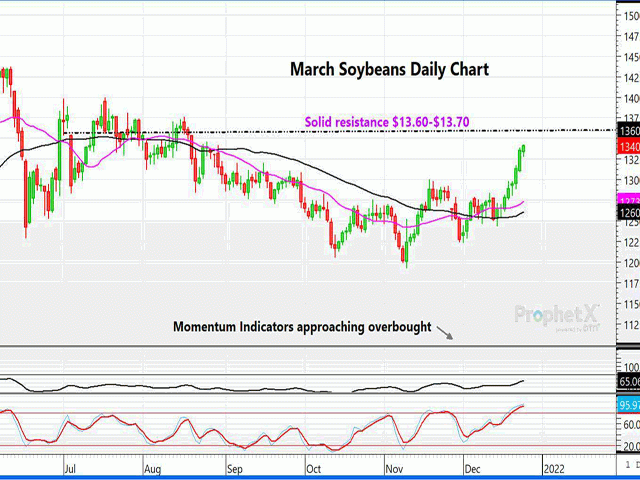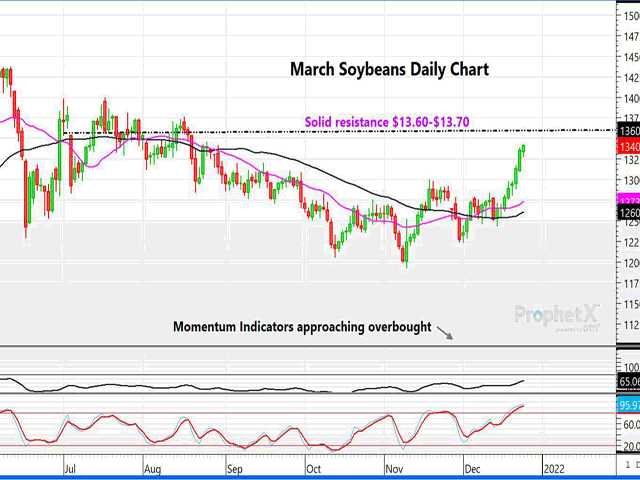Technically Speaking
March Soybeans May Be Getting Overdone in the Short Term
MARCH SOYBEAN FUTURES:
The direction of March soybeans will no doubt be tied closely to Sunday's mostly hot and dry weather forecast for both southern Brazil and Argentina, as drought is a major concern with La Nina strengthening. However, funds and small speculators have no doubt added to growing net-long positions, making that market vulnerable to profit-taking. While the expanding and continuing drought conditions can certainly change the global soy balance sheet in a bullish way, the fact remains that both U.S. soybean sales and inspections remain well below those of a year ago, by 21% to 24%, and, also well under the current USDA export projection. Watch for the $13.60 to $13.70 area on the March to provide plenty of solid resistance on a move higher early this week. Of course, all bets are off should the hot and dry pattern extend into mid-January or beyond; but a better chance of late week showers is predicted.
MARCH CORN FUTURES:
Just as in soybeans, spot corn futures have recently risen sharply on South American weather threats and solid demand. While U.S. corn export sales remain down 6% versus a year ago, that is still a better pace than USDA had projected. Domestic usage continues to be the bullish driver of demand, with ethanol margins still profitable and cattle on feed numbers just shy of a year ago. As in soybeans, the recent driver of strength seems to be South American weather. The mostly hot and dry pattern in southern Brazil and Argentina threatens production there. However, we all know weather markets are fickle and can change on a dime. With both Argentina and Brazil currently expected to produce nearly 36 million metric tons (mmt) (1.4 billion bushels) more corn than a year ago, it's still too early to tell if La Nina will decimate a portion of the crop. As in soybeans, the momentum indicators are approaching overbought conditions, suggesting a correction is more likely at some point. It would appear March corn could first challenge the $6.25 to $6.35 area, but funds have grown increasingly long and caution is advised.
MARCH SOYBEAN OIL FUTURES:
While it has recently been soybean meal that has helped propel the soybean market higher, it is soybean oil that has been everyone's short leg of soy product spreads. Soybean oil futures have bounced from the recent plunge, which saw March futures fall more than 11 cents per pound just since Nov. 24. World veg oil stocks remain tight and expectations are that soy oil usage for biodiesel should surge in coming months/years. Look for March soybean oil, on a solid close above 58 cents, send this market back toward the highs. Momentum is solidly higher, and March soy oil appears headed for a fourth straight higher finish.
Comments above are for educational purposes and are not meant to be specific trade recommendations. The buying and selling of grain and soybean futures involve substantial risk and are not suitable for everyone.
Dana Mantini can be reached at Dana.Mantini@DTN.com
Follow Dana on Twitter @mantini_r
(c) Copyright 2021 DTN, LLC. All rights reserved.
P[L1] D[0x0] M[300x250] OOP[F] ADUNIT[] T[]





Comments
To comment, please Log In or Join our Community .